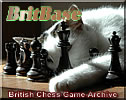BRITBASE - British Chess Game Archive
Event: Great Britain vs Netherlands Match • 20 games • last updated
Monday June 20, 2022 1:53 AM
Venue: Bonnington Hotel, London • Dates: 11-12 September 1948 • Download PGN
1948 Great Britain v Netherlands, 11-12 September, Bonnington Hotel, London
| Bd | Great Britain | Rd 1 | Rd 2 | Netherlands |
|---|---|---|---|---|
| 1 | Reginald Joseph Broadbent | 0-1 | ½-½ | Dr Max Euwe |
| 2 | Harry Golombek | 0-1 | 0-1 | Theo D van Scheltinga |
| 3 | Sir George Thomas | 1-0 | 1-0 | Lodewijk Prins |
| 4 | P Stuart Milner-Barry | 1-0 | 1-0 | Haije Kramer |
| 5 | C Hugh O'D Alexander | ½-½ | ½-½ | Nicolaas Cortlever |
| 6 | Gabriel Jacquin Wood | 0-1 | 1-0 | Willem Jan Mühring |
| 7 | Theodore Henry Tylor | 1-0 | 0-1 | Chris Vlagsma |
| 8 | Francis Ernest Appleyard Kitto | 0-1 | ½-½ | Hendrik Jan van Steenis |
| 9 | Dennis Morton Horne | ½-½ | ½-½ | Franciscus Henneberke |
| 10 | Richard Hilary Newman | 1-0 | 0-1 | Carel Benjamin van den Berg |
| Round scores | 5-5 | 5-5 | ||
| Total scores | 10-10 | |||
BCM, October 1948, ppn 333-334
ANGLO-DUTCH MATCH
This important match took place at the Bonnington Hotel, London, W.C.2, on September 11th and 12th, and resulted in a tie—10 all. Play was extraordinarily keen, there were only 6 draws in 20 games and these were all hard fights, some of them desperately exciting.
Mr. J. N. Derbyshire, the President of the British Chess Federation, once again showed his selfless devotion to the cause of British chess, for which chess players can never be grateful enough, by attending the fixture in person, although he lives in Nottingham and is over 80! On the second day he addressed the team and Mr. Zittersteyn, President of the Dutch Chess Federation, expressing the hope that this and similar matches would help to promote goodwill, friendly relations and peace between all nations.
Considerations of space make it impossible to comment on each game, though practically every game deserves individual attention. We cannot refrain from singling out Sir George Thomas, not because he won both his games, but because, in doing so, he produced chess of the highest class. Milner-Barry, too, showed excellent form in winning both his games as did van Scheltinga in twice overcoming Golombek who is so hard to beat. It will be an interesting match in the near future when he meets Dr. Euwe for the Championship of Holland. A notable performance was that of T. H. Tylor in the first round. Although his appearances are few and far between he always manages to give a good account of himself. The first game was both brilliant and original; in the second round the Dutch player took his revenge in equally drastic fashion. We shall give these and other outstanding games of the match in our next issue.
The styles of Mühring and G. Wood show some similarity in that they are both relentless in attack. Wood’s win in the second round was typical of his genius for conjuring up a fierce attack out of nothing, taking risks reminiscent of a tight-rope act. In this case the White King, faced with an overpowering concentration of forces, took to his heels and went from K Kt 1 to Q R 2. But with the mobility which characterizes Wood’s style, the whole of his attack was transferred in a twinkling to the other wing and a fine win was the result. We would have liked to give a diagram of the position, but the score was, unfortunately, in parts illegible.
In the first game against Dr. Euwe, Broadbent misjudged the position, a rare occurrence with him, and after allowing his opponent to win a pawn in the position shown in Diagram I, he found that the compensation for which he hoped was not forthcoming: 11 KtxB, QxKt; 12 Kt—Q 4, Castles; 13 BxKt, PxB; 14 RxB, P X R; 15 Kt x K P, Q—Kt 5; 16 Kt x R, Rx Kt; and Dr. Euwe won the ending in masterly fashion.
In the second game, Broadbent handled the opening splendidly and obtained a slight advantage as shown in Diagram 2, but it was not sufficient to win against Dr. Euwe’s adroit defence.
A very exciting finish was that between van Steenis and Kitto, the last game to finish late on Sunday night with the score at 9½ all! In Diagram 3 Kitto had a clearly won game; the simple move 48 .... RxP; was all that was required. Unfortunately, after seven hours’ play Kitto was desperately short of time and took what he thought to be the simplest line but which proved, in fact, most complicated. After 48 ..., P—R7; 49 KtxP, P—R 8(Q) ch; 50 P—K 4, Q—K1; 51 Kt—Kt5, QxP; 52 P—K 5 ch, K—B 2; 53 P—K 6 ch, K—B 3; 54 Kt—B 7, Q—Q 7 ch; 55 K—B 6, Q—B7 ch; 56 K—Q 7, Kitto was confronted (Diagram 4) with what looked like a possible loss.
Luckily he had 56 .... Q—R 5 ch; 57 K—B I, Q—Q 5; 58 P—K 7, drawn (58 P—Q 7, K—K 2; loses for White; Black simply Queens his pawn).
Thus ended a pleasant and memorable match.
File Updated
| Date | Notes |
|---|---|
| 16 March 1999 | First uploaded as a zipped PGN file. |
| 19 June 2022 | Table added, some forenames added or amended. |
